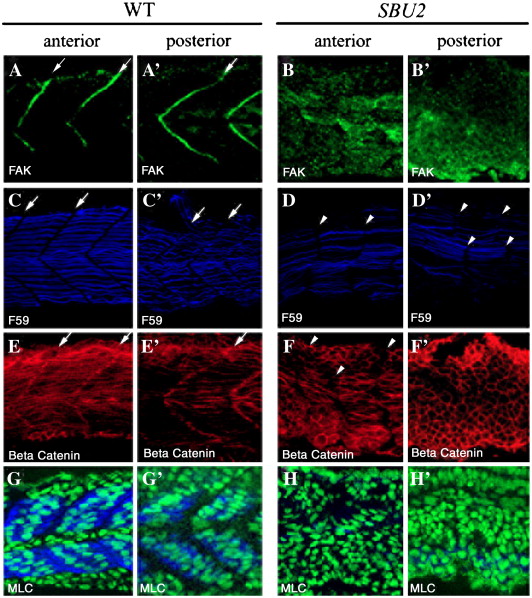Fig. 4 Somite boundary formation and muscle fiber differentiation are disrupted in SBU2 mutants. Confocal sections of anterior (A–H) and posterior (A′–H′) portions of the trunk region 29-somite stage embryos at approximately same medial–lateral and anterior–posterior locations; anterior to the left. Focal adhesion marker phosphorylated Fak is in green; slow muscle marker F59 is in blue; β-catenin which outlines the cell is in red. In wild-type embryos, phosphorylated Fak accumulates at myotome borders, revealing regularly formed somite boundaries (A and A′). On the other hand, there is no specific accumulation of phosphorylated FAK in SBU2 mutants (B and B′). The number of the slow muscle fibers is lower both in anterior and posterior (D and D′) compared to wild-type muscle fibers (C and C′). In wild-type embryos, fast muscle precursors elongate and attach to the anterior and posterior somite borders (E and E′). In SBU2 mutant embryos, some fast cells elongate in the anterior of the embryos (F). However, in the posterior, few, if any, fast cells elongate (F′). Likewise, the MLC antibody F310 staining (blue) is abundant in wild-type muscle (G and G′) but absent in SBU2 mutant embryos (H and H′), nuclei are labeled with cytoxgreen. Therefore, fast muscle fiber morphogenesis is severely disrupted in SBU2 mutant embryos. Arrows denote somite boundaries. Arrowheads denote improper and degenerated somite boundaries.
Reprinted from Developmental Biology, 307(2), Kok, F.O., Oster, E., Mentzer, L., Hsieh, J.C., Henry, C.A., and Sirotkin, H.I., The role of the SPT6 chromatin remodeling factor in zebrafish embryogenesis, 214-226, Copyright (2007) with permission from Elsevier. Full text @ Dev. Biol.

